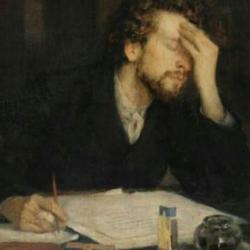More notes toward a lecture.
Shakespeare’s Hamlet exists in three significantly different forms. The earliest published text, the First Quarto or the “Bad Quarto,” appeared in 1603. Though recognizably Shakespeare’s play, it is different in many significant ways, and scholars have speculated that it is the product of one of the actors’ notes or memory. The opening lines of the First Quarto are these:
Enter two Centinels.
1. STand: who is that?
2. Tis I.
1. O you come most carefully vpon your watch,
2. And if you meete Marcellus and Horatio,
The partners of my watch, bid them make haste.
1. I will: See who goes there.
And Hamlet’s “To be or not to be” is rendered as:
To be, or not to be, aye, there’s the point,
To die, to sleep, is that all? Aye, all.
No, to sleep, to dream, aye merry, there it goes,
For in that dream of death, when we awake,
And borne before an everlasting Judge,
From whence no passenger ever returned,
The undiscovered country, at those sight
The happy smile, and the accursed damned.
But for this, the joyful hope of this,
Who’d bear the scorns and flattery of the world,
Scorned by the right rich, the rich cursed of the poor?
The widow being oppressed, the orphan wronged,
The taste of hunger, or a tyrant’s reign,
And thousand more calamities besides,
To grunt and sweat under this weary life,
When that he may his full quietus make,
With a bare bodkin? Who would this endure,
But for a hope fo something after death?
Which puzzles the brain, and doth confound the sense,
Which makes us rather bear those evils we have,
Than fly to others that we know not of.
Aye that, oh this conscience makes cowards of us all.
A year later, a Second Quarto appeared, twice as long as the first. According to Colin Burrow, this version contains most of the Hamlet that we know as the play: “It’s not simply Shakespeare, though. The compositor (the printer who set the type) clearly found the manuscript a pig to read. When this Hamlet sees Claudius praying and decides not to kill him because doing so would send him to heaven, he says: ‘This is base and silly, not revenge.’ The words the printer had before him and misread were not ‘base and silly’ but ‘hire and salary.’ Hamlet meant that sending Claudius to heaven would be a reward rather than a punishment for his murder of old Hamlet. ‘Base and silly’ probably does not reflect what Shakespeare wrote. But despite these problems the Second Quarto is probably closest to Shakespeare’s earliest and longest version.”
Finally, in 1623, a third version was published, known as the First Folio, shorter than the Second Quarto but longer than the Bad Quarto. Burrow writes, “The folio version of the play may have been cut down for performance and it may well be that Shakespeare himself revised the text. The folio Hamlet is a quirkier character than the quarto Hamlets. He habitually echoes phrases and seems to reflect on his words.”















